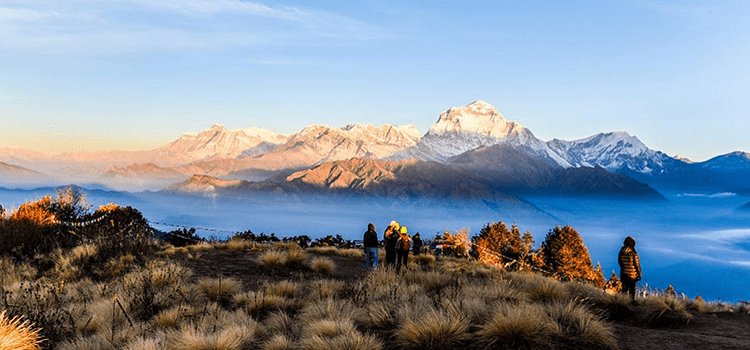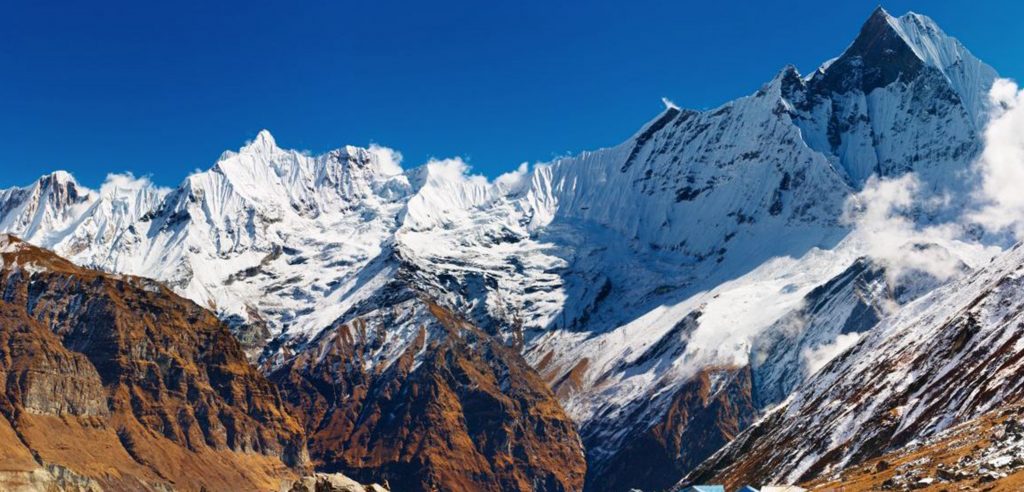The journey to Annapurna Base Camp is often regarded as one of the best treks in the world. The route to Annapurna Base Camp is considered to be one of the most famous and iconic treks in the world. Hikers come from all over the globe to complete this trek. The trek to Annapurna is also sometimes referred to as the Sanctuary of the Annapurna base camp trek.
It brings you so close to an eight-thousander that it’s almost like you’re face to face with it, which is quite astounding for a route that’s just moderately demanding. The captivating Annapurna range is home to the tenth highest peak in the world. Mountaineers have an unhealthy obsession with Annapurna I, which stands at 8,091 metres. Compared to the other eight thousand, it has the greatest rate of fatalities. The ABC hike, despite its intimidating aspect, offers mountain lovers a vast assortment of unique and exciting finds along the way.

Image: (Poon Hill) (Unknown)
It offers a magnificent combination of environment and culture, as well as a breathtaking vantage point of some of the highest mountains in the world. Additionally, it is regarded as one of the most beautiful panoramas on the whole globe. The path takes you through a variety of ecosystems, communities, and breathtaking landscapes, such as mountain ranges, terraced farms, and a wide diversity of flora and fauna.
The Annapurna range is a great mountain range to watch from Pokhara since it satisfies your hunger for mountain scenery. This is happening even before you set out on your quest. The views from Ghandruk are very breathtaking, particularly those of Machapuchare, Annapurna South, and Hiunchuli. As you make your way to Sinuwa, you will be accompanied by views of many peaks located within the Annapurna range as well as Machapuchare. You will feel taunted by the tip of Machapuchare while you are at Dovan. As you make your way out of the woods and pass Himalaya and Deurali on your way, Machapuchare will be revealed in all of its splendour.

Image: (Annapurna Base Camp) (Unknown)
Machapuchare, often known as the “fish-tailed mountain,” is held in high regard across Nepal for its striking aesthetic. There is a legend that asserts it to be one of Lord Shiva’s homes. There is no record of anybody having successfully climbed it! From the base camp at Machapuchare, you will get excellent views of not only Machapuchare but also Annapurna I, Annapurna South, Gangapurna, and Hiunchuli.
The trail meanders through an assortment of different types of vegetation. The route from Ghandruk to Chomrung is lined on each side by rhododendron bushes, ferns, and bamboo. As you continue to go over Sinuwa into the Annapurna refuge, the vegetation around you will become denser. The scenery is dominated by majestic oak trees in this area. As you get closer to Deurali, the thick trees you passed through on the way up give way to beautiful grass. This area has daphne trees, some of which have very thick bark. Paper is made using this by the local population. In addition to being found in the area of Sandakphu, these trees may also be found there. As you approach the base camp of Machapuchare, the environment changes to become more alpine. In certain places, there is grass growing amid the stones. This section of the trail is likewise bordered on each side by flowering plants.
The trail may be split up into three distinct portions by dense foliage that allows very little sunlight to get through it. The first one starts right after all of the settlements that are located around Chomrung and go all the way to New Bridge. Along the trail that leads from Sinuwa, the Modi Khola rushes by in close proximity to you. On the other hand, due to the deep nature of the forests that surround the river, it is impossible to view it. The third leg of the journey goes on to Dovan after it passes through Bamboo. The best part about this trip is that it takes you through some gorgeous woods on two separate occasions.
The trek is conducted entirely inside the Annapurna Conservation Area, which has a total land area of 7,629 square kilometres. This area is home to 102 mammal species, 474 bird species, 33 reptile species, and 22 amphibian species in addition to its 1,226 types of flowering plants. If you’re fortunate, you could get a glimpse of an exotic bird or perhaps a marmot.
This excursion takes place at a typical tea house. You will be staying in comfortable lodges that have the capacity to accommodate 20–25 people. Locals are the ones in charge of them. During the tourist season, many people from other parts of Nepal relocate here in order to find jobs. Your conversations with the people who run the tea houses, as well as the guides and porters who are accompanying you on the hike, will provide you with valuable insight into their way of life. The vast majority of people are English speakers, so communication shouldn’t be too tough. The food that is served at tea rooms is often prepared in a traditional Nepalese fashion.
Ghandruk is the community in this area with the highest population density. When you first start out on your adventure, you will go through a number of smaller communities, each of which has fewer than one hundred people living in it. This path is routinely used by locals on their way to and from their homes and farms. As a consequence of this, you should anticipate seeing villagers up until you get to Sinuwa, which is where the Annapurna Sanctuary officially starts. Just on the outskirts of the communities, one may see banana plantations as well as rice fields.
Trip highlights:
- Wonderful panoramic views
- Get into Nepali life and discover the typical village of Nepal.
- Visit the heart of the Shrine of Annapurna
- In Katmandu, you may go to the Hindu Shrine of Pashupatinat as well as the enormous Buddhist stupa of Boudhanath.
- The views from the seventh and tenth highest peaks in the world, respectively, are Dhaulagiri I and Annapurna I.)
- Spectacular views of glaciers and mountain
Trek Facts: Is this trip right for you?
LOCATION: Annapurna base camp
ELEVATION: 4130 m
CURRENCY: Nepalese rupee (NPR)
Nearest Airport: Tribhuvan International Airport, Pokhara Airport
TIME ZONE: DST not complied with in Nepal Standard Time (UTC+05:45)
TRAVEL STYLE: ACTIVE: Outdoor adventures such as hiking, trekking, cycling, rafting and kayaking.
SERVICE LEVEL: BASIC: Clean and easy (tea-house / lodge) hotels and hostels, accessible public and private transit, other available amenities.
PHYSICAL RATING: MEDIUM/ AVERAGE
TRIP TYPE: SMALL GROUP: Avg 12, Max 15
AGE REQUIREMENT: 12 + An adult must be accompanied by any traveller under the age of 18.
PERMIT NEEDED: ACAP, TIMS
SEASONS: January, February, March, April, May, September, October, November, December
Outline Itinerary
Day 01 – Arrive in Kathmandu (1,400 m). Overnight at a Hotel.
Day 02 – Kathmandu Sightseeing Tour. Rest of day at leisure.
Day 03 – Kathmandu – Pokhara (Flight or drive 7-8 hrs)
Day 04 –Pokhara – drive to Nayapul (1 1/2 hrs) – trek to Tikhedhunga (1570 m) or Ulleri (1940 m) 6-7 hrs
Day 05 –Tikhedhunga (1570 m) or Ulleri (1940 m) – Ghorepani (2750 m) 5-6 hrs
Day 06 – Ghorepani (2750 m) – Poon Hill (3210 m) – Tadapani (2650 m) 6 hrs.
Day 07 – Tadapani (2650 m) – Chomrong (2170 m) 5 hrs
Day 08 – Chomrong (2170 m) – Dovan (2600 m) 6-7 hrs
Day 09 – Dovan (2600 m) – Machapuchare Base Camp (3700 m) 7-8 hrs
Day 10 –Machapuchare Base Camp (3700 m) – Annapurna Base Camp (4130 m) 3 hrs
Day 11 –Annapurna Base Camp (4130 m) – Bamboo (2310 m) 7-8 hrs
Day 12 – Bamboo (2310 m) – Jhinu Danda (1780 m) via Chomrong; visit hot springs 7 hrs
Day 13 –Jhinu Danda (1780 m) – Pothana (1870 m) via Landruk, 7 Hrs
Day 14 – Pothana (1870 m) – Kande via Australian Camp, drive 1 hr to Pokhara
Day 15 –Flight Pokhara – Kathmandu, or drive 7-8 hrs
Day 16 – Kathmandu-Final Departure
How difficult is Annapurna Base Camp trek?
After Everest Base Camp, the path that leads to Annapurna Base Camp is widely considered to be among the most beautiful and well-known hiking trails in all of Nepal. This trail is popular not only with first-time hikers but also with seasoned mountaineers, as well as those who travel by themselves or in groups.
The trip to Annapurna Base Camp is not regarded as tough due to the fact that it is somewhat adventurous, and the most essential components of the route are to walk slowly and softly. As a direct consequence of this, this path has a moderate difficulty rating. The trek to Everest Base Camp is arduous and magnificent, but with enough patience, it is possible to enjoy it and complete it.
The trek to Annapurna Base Camp is categorised as “Moderately Difficult” or “Medium” or “Average” in terms of its level of difficulty. There are two primary factors that contribute to the overall rating of the ABC journey: Moderate-Difficult / (MEDIUM/ AVERAGE)
Before everything else, think about how far it is. A total of 67 kilometres are covered by the hiker during the course of 10 days of hiking. This itinerary includes three days in which you travel more than 10 kilometres, the longest of which is 15.5 kilometres and takes you from ABC to Bamboo.
The tremendous rise and fall in height is another factor to consider. The excursion starts at an elevation of little more than 7,300 feet in Komrong and quickly ascends to an altitude of 13,550 feet at the ABC. Over the course of the fifth day of the journey, the path will ascend about 1,200 metres, which is equivalent to 4,000 feet. Before embarking on the journey, it is important to give this some thought.
When is the ideal time to trek to Annapurna Base Camp?
There are four different seasons that occur in Nepal. The spring, summer, fall, and winter seasons make up the four seasons. Any time of the year is appropriate to complete the trek to Annapurna Base Camp. However, the monsoon season is not the best time to go. Even though cloudy skies are present at all times, evenings and nights are marked by heavy downpours. Because of this, it is likely that you won’t be able to view the beautiful peaks. It also implies slippery roads, leeches, and other insects, as well as the possibility of landslides. On the other hand, this is the time of year when animals are most likely to be active. If you are interested in biology, the monsoon season is an excellent time to study it.
The optimum time to do this trip is in the fall. It’s a dry time of year, with a clear blue sky and comfortable temperatures. As a consequence, this is a very popular time of year to go hiking in Nepal.
You might go in December if you like to go to a more tranquil time of year. ABC may also be accessed throughout the winter months. Although it will be fairly frigid and snowy throughout the duration of winter, the air will be dry and the sky will be bright, providing the best visibility possible. If you want to go on a hike in December, you need to be sure that you are fully equipped and that your gear is appropriate.
When travelling from Deurali to Machhapuchhre Base Camp, you need to be aware of the possibility of avalanches beginning in January. Along this section of the road, there is the potential for avalanches. No matter what time of year it is, hikers making the journey from Deurali to Machhapuchhre Base Camp need to exercise extreme caution.
The spring is another wonderful time to make the journey to Annapurna Base Camp. Nevertheless, maintain a sharp lookout for the avalanche. Pay attention to what the locals have to say about the avalanche that is about to occur. In the spring, the path will be adorned with red and white rhododendrons as well as many other exotic blossoms that are typical of this area. As a result, this season is an excellent time for botanists to go there.
We are eager to learn more about it and will do our best to respond to any further questions that you may have in the comments area below.











Subscribe To Our Newsletter
Join our mailing list to receive the latest news and updates from our team.
You have Successfully Subscribed!